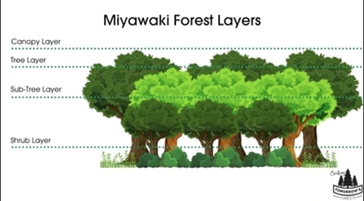

Context
There are hundreds of thousands of Miyawaki forest trees in India. Also, this method is quickly finding favour in government corridors and corporate boardrooms to restore urban spaces.
Background
What is the concept of Miyawaki Forest?
- Miyawaki is a technique pioneered by Japanese botanist Akira Miyawaki, which helps build dense, native forests.
- It is effective because it is based on natural reforestation principles, i.e. using trees native to the area and replicating natural forest regeneration processes.
- It has some significant benefits over more traditional forestry methods when used in smaller afforestation projects and is particularly effective in the urban environment.
- The trees planted by this method grow much faster, jump starting the forest creation process and capturing more carbon.
- The approach is supposed to ensure that plant growth is 10 times faster and the resulting plantation is 30 times denser than usual.
- It involves planting dozens of native species in the same area, and becomes maintenance-free after the first three years.
- Higher biodiversity has been recorded in Miyawaki forests than in neighbouring woodland, so it’s an ideal method for creating diverse forest ecosystems quickly.
- Within the context of the current climate change emergency and stark warnings about the global loss of biodiversity, being able to create diverse, healthy forests quickly could prove vital to meeting international targets and tackling these issues.

What are the benefits?
- Trees in a Miyawaki forest grow up to ten times faster at around a metre per year, reaching a stable multi-layered forest community in 20 to 30 years instead of hundreds of years
- The growing trees absorb more carbon in a Miyawaki forest than in a plantation or in standard afforestation projects because they grow more quickly and there are thirty times as many
- The Miyawaki method has been successful where other planting projects have failed, such as in arid Mediterranean habitats, due to high survival rates
- Native trees thrive in the conditions to which they are adapted and are more resilient to environmental changes
- Miyawaki forests have been found to have far higher biodiversity than neighbouring woodland, on average 18 times higher
Criticism of the Miyawaki Method:
- Critics have accused him of shilling for corporations like Toyota, which have contributed to deforestation in places such as India, and of creating monotonous-looking forests that are expensive to boot.
- Environmentalists have questioned the efficacy of the method that accelerates the growth of trees and claims to match a forest’s complex ecosystem. They believe that it is not a good idea to force plants to photosynthesise fast. Also, a forest is not just the trees, but a complex ecosystem.
- The technique was started by the Japanese considering the climate in Japan and the regular occurrence of natural calamities like earthquakes. Environmentalists have questioned the suitability of the method for a tropical country like India.
- Miyawaki forests can only be grown at smaller spaces in or near cities. Such forests also lack some qualities of natural forests, such as medicinal properties and the ability to bring rain.
- Miyawaki Forests are very dense, which restricts the movement of any possible wildlife the forest might attract. Experts are of the opinion that nothing can replace something that is very natural in its form, like natural forests. However, it cannot be denied that these plantations can supplement and complement them.


